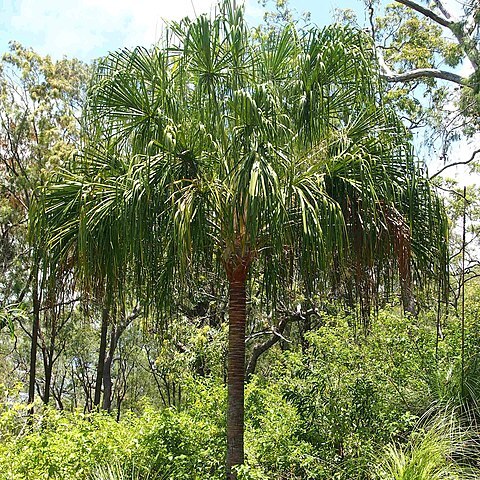Trunk to 18 m tall, 25–30 cm diam., grey, smooth. Leaves 30–60, in a broad, flattish crown; petiole 150–280 cm long, 18–24 mm wide, with small thorns on proximal margins; leaf blade circular, 120–185 cm long, coriaceous, yellowish green, abaxially glabrous, divided nearly to base; segments 70–84, distally pendulous, deeply bifurcate, with attenuate lobes. Inflorescence 100–350 cm long, branched to 4 orders; bracts glabrous to papillose; rachillae minutely papillose. Flowers solitary or in sympodial clusters of 2–6, funnel-shaped, yellow; sepals ovate-triangular, c. 1.3 mm long, obtuse, membranous; petals broadly ovate, 1.5–1.8 mm long, obtuse, fleshy; stamens c. 1.5 mm long. Fruit globose, 12–18 mm diam., black, shiny. Seed globose, c. 10 mm diam.
More
A palm. The trunk is slender and grey. It can be 20 m tall. The trunk can be 40 cm across. It is light grey to whitish. The crown is rounded. The leaf stalk extends into the leaf blade. The leaf stalk is 2.5-3 m long and 5-6 cm across at the base. The leaves are large and yellowish-green. The leaf blade is 1-1.5 m long. They are finely divided. They are fan shaped with drooping tips. The flowers are bright yellow. They occur in clusters in the centre of the crown. The flowering stalks are 1 m long. The flowers are 0.2 cm across. The fruit are 1 cm across. They are blue-black when ripe.
A tropical plant. It can grow in warm temperate, subtropical and tropical regions. It needs a well-drained but moist soil. Young plants respond to applications of fertiliser. It grows in coastal regions. In the Cairns Botanical Gardens. It suits hardiness zones 9-11.
More
Grows in coastal and near-coastal lowlands, and infrequently inland at moderate elevation, usually in small groups, in open forest, littoral rainforest and dry rainforest; also along streams and on swamp margins.


